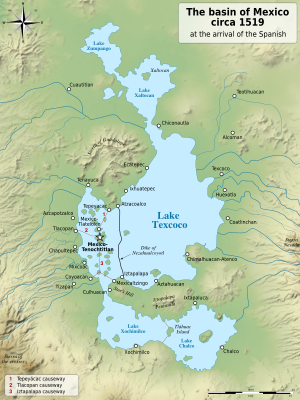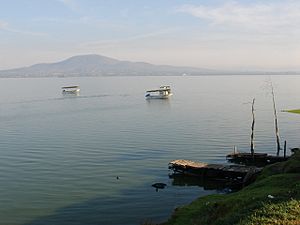Lake Zumpango facts for kids

Lake Zumpango (also known as Laguna de Zumpango in Spanish) is a special kind of lake called an endorheic basin. This means water flows into it but doesn't flow out to the ocean. It's located in the Valley of Mexico, near the town of Zumpango.
Long ago, Lake Zumpango was the northernmost of five big lakes that were all connected. These lakes covered a huge area, about 1,500 square kilometers (579 square miles)! The other lakes were Lake Xaltocan, Lake Xochimilco, Lake Chalco, and Lake Texcoco. The Valley of Mexico was a very important place for ancient civilizations like the Teotihuacan people, the Toltec, and the Aztec Empire.
After the Spanish took over the Aztec Empire, they started to drain the lakes. They did this to stop big floods that kept happening in Mexico City. Over many years, Lake Zumpango lost its water sources and became polluted with dirty water and trash. But good news! In recent times, the lake is slowly getting cleaner again.
Contents
What is the History of Lake Zumpango?
Ancient Times: Before the Spanish Arrived
People lived near Lake Zumpango a very long time ago. We know this because settlements have been found there that date back to around 200 BC to 100 AD. This shows that the area has been important for thousands of years!
Spanish Rule and Draining the Lakes
The idea to drain the lakes first came up after a big flood hit colonial Mexico City in 1555. To solve this, the Spanish started building a drainage canal in 1605. This first canal was meant to carry water from Lake Zumpango north towards Huehuetoca. It also helped to move water from the Cuautitlán River away from the lakes and towards the Tula River.
A man named Enrico Martínez worked on this huge project for 25 years! He successfully built a canal in this area, which he called Nochistongo. This canal sent water to the Tula Valley. However, even with this canal, the drainage wasn't enough to stop the "Great Flood" that hit Mexico City in 1629. Later, another canal, called the "Grand Canal," was built next to the Nochistongo one, ending in Tequixquiac. These canals changed the landscape of the Valley of Mexico forever.
What Animals Live in Lake Zumpango?
Lake Zumpango was once home to the axolotl, a special type of salamander. Axolotls are amphibians, meaning they can live both in water and on land. Sadly, because the lake's environment was damaged, the axolotl is now critically endangered. This means there are very few of them left in the wild.
 In Spanish: Lago de Zumpango para niños
In Spanish: Lago de Zumpango para niños



